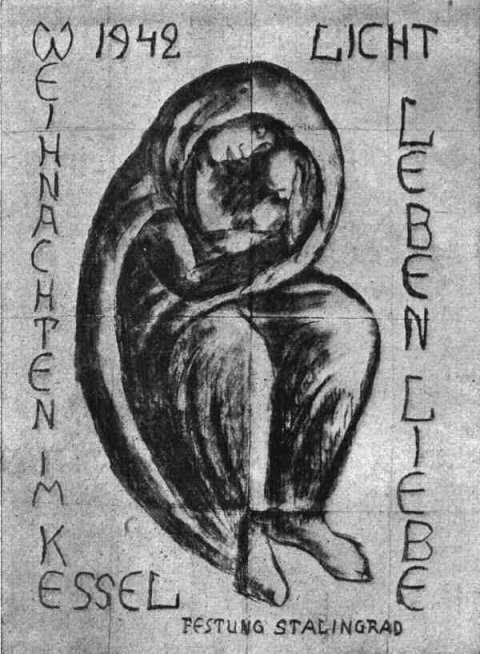 Madonna of Stalingrad: Drawn by a German Chaplain and physician the piece was taken out of the city by one of the last officers to get out. It is now displayed in the Kaiser Wilhelm Memorial Church in Berlin
Madonna of Stalingrad: Drawn by a German Chaplain and physician the piece was taken out of the city by one of the last officers to get out. It is now displayed in the Kaiser Wilhelm Memorial Church in Berlin
Sunday the 31st of January marks the surrender of the remnants of the German 6th Army to the Soviets at Stalingrad. The focus of this article is on how the Germans and Russians fought the Stalingrad campaign. In particular it is an analysis of the way the governments and military’s of both Nazi Germany and the Soviet Union planned and executed strategy during the course of the campaign adjusted to the situation and how the campaign ended. It is also a reminder of the price that ordinary soldiers can pay when a country commits them to war. I conclude with a potential modern application for the US and NATO in Afghanistan.
Stalingrad: Primary or Secondary Objective
 The mistakes began early in the planning and conduct of the operation
The mistakes began early in the planning and conduct of the operation
Following the Soviet winter offensive and the near disaster in front of Moscow the German High Command was faced with the strategic decision of what to do in the 1942 campaign. Several options were considered and it was decided to seize the Caucasus oilfields and capture or neutralize the city of Stalingrad on the Volga. However, the High Command was divided on the actual objective of the campaign.
OKH under the guidance of General Halder assumed that Stalingrad was the objective and the advance into the Caucasus was a blocking effort.[i] Hitler and OKW planned to capture the Caucasus oil fields and capture or neutralize Stalingrad to secure the left flank.[ii] Both OKH and OKW considered Stalingrad significant but “German commanders initially regarded it as a weigh station en route to the Caucasus oil fields.”[iii] The conflict echoed in the ambiguity of Directive No. 41 which “included the ‘seizure of the oil region of the Caucasus’ in the preamble concerning the general aim of the campaign, yet made no mention of this in the main plan of operations.”[iv] At the planning conference held at Army Group South in early June “Hitler hardly mentioned Stalingrad. As far as his Generals were concerned it was little more than a name on the map. His obsession was with the oil fields of the Caucasus.”[v] Manstein noted that “Hitler’s strategic objectives were governed chiefly by the needs of his war economy….”[vi] Anthony Beevor notes that at this stage of planning “the only interest in Stalingrad was to eliminate the armaments factories there and secure a position on the Volga. The capture of the city was not considered necessary.”[vii] German planners “expected that the Soviets would again accept decisive battle to defend these regions.”[viii]
In Moscow Stalin and his Generals attempted to guess the direction of the impending German offensive. “Stalin was convinced that Moscow remained the principle German objective…Most of the Red Army’s strategic reserves…were therefore held in the Moscow region.”[ix] To disrupt the German offensive and to attempt to recover Kharkov three offensives were launched by Red Army forces under the direction of Stavka. The largest of these on Kharkov was defeated between 12-22 May with the loss of most of the armor in southern Russia. This coupled with an equally disastrous defeat of Red Army forces in Crimea by Von Manstein’s 11th Army meant that the Red Army would face the Germans in a severely weakened condition.[x]
Operation Blau: Opening Moves and Divergent Objectives
The German offensive began on 28 June under the command of Field Marshal von Bock. Bock’s command included two separate army groups, Army Group B under General Von Weichs with 2nd Army, 6th Army and 4th Panzer Army operated in the northern part of the operational area. Army Group A was to the south with 17th Army and 1st Panzer Army.[xi] Army Group B provided the main effort and quickly smashed through the defending Soviet armies and by the 20th Hitler believed that “the Russian is finished.”[xii] One reason for the German success in the south was that until July 7th Stalin believed that Moscow was still the primary objective.[xiii] Bock was prevented by Hitler from destroying Soviet formations left behind and was relieved of command by Hitler. He was replaced by Von Weichs which created a difficult command and control problem. Manstein noted that this created a “grotesque chain of command on the German southern wing” with the result that Army Group A had “no commander of its own whatever” and Army Group B had “no few than seven armies under command including four allied ones.”[xiv]
This decision proved fateful. Hitler’s decided to redirect the advance of the 4th Panzer Army to support an early passage of the lower Don, diverting it from its drive on Stalingrad. Additionally the army groups became independent of each other when Bock was relieved of command. They were “assigned independent-and diverging-objectives” under the terms of Directive No.45.[xv] This combination of events would have a decisive impact on the campaign. The decision prevented a quick seizure of Stalingrad by 4th Panzer Army followed by a hand over to 6th Army to establish the “block” as described by Directive No.41. Kleist noted that he didn’t need 4th Panzer Army’s help to accomplish his objectives and that it could have “taken Stalingrad without a fight at the end of July….”[xvi]
The result was damning. Air support and fuel needed by Army Group A was transferred to 6th Army, denuding Army Group A of the resources that it needed to conclude its conquest of the Caucasus.[xvii] At the same time it denied Army Group B of the Panzer Army that could seize Stalingrad when it was still possible to do so. Beevor calls Hitler’s decision a disastrous compromise.[xviii] Halder believed the decision underestimated the enemy and was “both ludicrous and dangerous.”[xix]
Focus on Stalingrad
 Sturmgeschutz Battalion Advancing toward Stalingrad
Sturmgeschutz Battalion Advancing toward Stalingrad
On July 22 as the Wehrmacht ran short on fuel and divisions to commit to the Caucasus, and 6th Army fought for control of Voronezh the Soviets created the Stalingrad Front. Stavka moved an NKVD Division to the city,[xx] and rapidly filled the new front with formations transferred from the Moscow Front.[xxi] Stalin issued Stavka Order 227, better known as “No Step Back” on 28 July. The order mandated that commanders and political officers who retreated would be assigned to Penal battalions[xxii] and armies were to form three to five special units of about 200 men each as a second line “to shoot any man who ran away.”[xxiii] Russian resistance west of the Don slowed the German advance. German commanders were astonished “at the profligacy of Russian commanders with their men’s lives.”[xxiv] Von Kleist compared the stubbornness of Russians in his area to those of the previous year and wrote that they were local troops “who fought more stubbornly because they were fighting to defend their homes.”[xxv] Additionally, Stalin changed commanders frequently in the “vain hope that a ruthless new leader could galvanize resistance and transform the situation.”[xxvi] General Chuikov brought the 64th Army into the Stalingrad Front in mid-July to hold the Germans west of the Don.[xxvii]
 German Militarpfarrer (Chaplain) leading field service in August 1942
German Militarpfarrer (Chaplain) leading field service in August 1942
Further weakening the Germans OKW transferred key SS Panzer Divisions and the Grossdeutschland Division to France. Supporting Hungarian, Italian and Romanian allied armies which lacked motorization, modern armor or anti-tank units were unable to fulfill the gaps left by the loss of experienced German divisions and the expectations of Hitler.[xxviii] 6th Army was virtually immobilized for 10 days due to lack of supplies allowing the Russians to establish a defense on the Don Bend.[xxix] To the south the Germans were held up by lack of fuel and increased Soviet resistance including the introduction of a force of 800 bombers.[xxx] Glantz and House note that with the fall of Rostov on July 23rd “Hitler abruptly focused on the industrial and symbolic value of Stalingrad.”[xxxi] Undeterred by warnings from Halder that fresh Russian formations were massing east of the Volga and Quartermaster General, Wagner, who guaranteed that he could supply either the thrust to the Caucasus or Stalingrad but not both.[xxxii] Again frustrated by slow progress Hitler reverted to the original plan for 4th Panzer Army to assist 6th Army at Stalingrad, but the cost in time and fuel were significant to the operation and the question was whether “they could make up for Hitler’s changes in plan.”[xxxiii]
Strategic Implications
 General Chuikov who directed the defense of Stalingrad during the battle
General Chuikov who directed the defense of Stalingrad during the battle
 Soviet Naval Infantry and Political Officer
Soviet Naval Infantry and Political Officer
The changes in the German plan had distinct ramifications for both sides. Von Mellenthin wrote that “the diversion of effort between the Caucasus and Stalingrad ruined our whole campaign.”[xxxiv] The Germans could not secure the Caucasus oil fields which Hitler considered vital to the German war effort. They advanced deep into the region and captured the Maikop oil fields, though they were almost completely destroyed by the retreating Russians.[xxxv] Army Group A was halted by the Russians along the crests of the Caucasus on August 28th.[xxxvi] This left Hitler deeply “dissatisfied with the situation of Army Group A.”[xxxvii] Kleist and others attributed much of the failure to a lack of fuel[xxxviii] and Blumentritt noted that Mountain divisions that could have made the breakthrough were employed along the Black Sea coast in secondary operations.[xxxix]
Fuel and supply shortages delayed 6th Army’s advance while Hoth’s 4th Panzer Army was needlessly shuttled between Rostov and Stalingrad. By the time it resumed its advance the Russians “had sufficiently recovered to check its advance.”[xl] As 6th Army advanced the “protection of Army Group B’s ever-extending northern flank was taken over by the 3rd Rumanian, the 2nd Hungarian and the newly formed 8th Italian Army.”[xli] The allied armies were neither equipped for the Russian campaign nor well motivated.[xlii] The supply shortage in both army groups was not helped by a logistics bottleneck. All supplies came over a single Dnieper crossing, which Manstein noted, prevented swift movement of troops from one area to another.[xliii]
 Reconnaissance Battalion of 24th Panzer Division near Stalingrad
Reconnaissance Battalion of 24th Panzer Division near Stalingrad
Von Paulus’ 6th Army now attempted to rush Stalingrad between the 25th and 29th of July, while Hoth milled about on the lower Don. However, Paulus’s piecemeal commitment of his divisions and failure to concentrate in the face of unexpectedly strong Soviet resistance caused the attacks to fail. Paulus halted 6th Army on the Don so it could concentrate its forces and build its logistics base,[xliv] and to allow Hoth to come up from the south. This delay allowed the Russians to build up forces west of Stalingrad and reinforce the Stalingrad front and strengthen the defenses of the city,[xlv] and due to the distances involved it was easier for the Russians to reinforce the Stalingrad front.[xlvi] It also allowed the Russians to fill a number of key leadership positions with Generals who would skillfully fight the battle.[xlvii]
 Russian Naval Infantry during early phase of battle
Russian Naval Infantry during early phase of battle
Hitler now focused on the capture of Stalingrad despite the fact that “as a city Stalingrad was of no strategic importance.”[xlviii] Strategically, its capture would cut Soviet supply lines to the Caucasus,[xlix] but this could be achieved without its capture. The checks in the south “began to give Stalingrad a moral importance-enhanced by its name-which came to outweigh its strategic value.”[l] To Hitler Stalingrad would gain “a mystic significance”[li] and along with Leningrad became “not only military but also psychological objectives.”[lii]
 Red Army Armored troops using Lend-Lease American M3 Stuart and M3 Grant tanks
Red Army Armored troops using Lend-Lease American M3 Stuart and M3 Grant tanks
The Germans mounted a frontal assault with 6th Army and elements of 4th Panzer Army despite air reconnaissance that “the Russians are throwing forces from all directions at Stalingrad.[liii] Paulus as the senior General was in charge of the advance, with Hoth subordinated to him, but the attack had to wait until Hoth’s army could fight its way up from the south.[liv] Von Mellenthin comments rightly that “when Stalingrad was not taken on the first rush, it would have been better to mask it….”[lv] It is clear that the German advance had actually reached its culminating point with the failure of the advance into the Caucasus and Paulus’s initial setback on the Don, but it was not yet apparent to many involved.[lvi] The proper course of action would have been to halt and build up the front and create mobile reserve to parry any Russian offensive along northern flank while reinforcing success in the Caucasus. Manstein wrote that “by failing to take appropriate action after his offensive had petered out without achieving anything definite, he [Hitler] paved the way to the tragedy of Stalingrad!”[lvii]
Transfixed by Stalingrad
On August 19th Paulus launched a concentric attack against the Russian 62nd and 64th Armies on the Don. The attack ran into problems, especially in Hoth’s sector.[lviii] Yet, on the 22nd the 14th Panzer Corps “forced a very narrow breach in the Russian perimeter at Vertyachi and fought its way across the northern suburbs of Stalingrad,”[lix] and reached the Volga on the 23rd. That day 4th Air Fleet launched 1600 sorties against the city dropping over 1,000 tons of bombs.[lx] The breakthrough imperiled the Soviet position they had concentrated their strongest forces against Hoth.[lxi] The Germans held air superiority and continued heavy bombing attacks. During the last days of August 6th Army “moved steadily forward into the suburbs of the city, setting the stage for battle.”[lxii] As the Soviets reacted to Paulus, Hoth achieved a breakthrough in the south which threatened the Russian position. However 6th Army was unable to disengage its mobile forces to link up with the 4th Panzer Army and another opportunity had been missed.[lxiii]
As 6th Army moved into the city Yeremenko ordered attacks against Hube’s 16th Panzer Division and Soviet resistance increased as more formations arrived the Germans suffered one of their heaviest casualty rates.”[lxiv] Though unsuccessful the counterattacks “managed to deflect Paulus’s reserves at the most critical moment.”[lxv] The Germans remained confident the first week of September as 6th Army and 4th Panzer Army linked up, but Yeremenko saved his forces by withdrawing and avoiding encirclement west of the city, retiring to an improvised line close to the city.[lxvi] On September 12th Chuikov was appointed to command 62nd Army in Stalingrad. Chuikov understood that there “was only one way to hold on. They had to pay in lives. ‘Time is blood,’ as Chuikov put it later.”[lxvii] Stalin sent Nikita Khrushchev to the front “with orders to inspire the Armies and civilian population to fight to the end.”[lxviii] 13th Guards Rifle Division arrived on the 14th saved the Volga landings but it lost 30% casualties in its first 24 hours of combat.[lxix]
An NKVD regiment and other units held the strategically sited Mamaev Kurgan, keeping German guns from controlling the Volga.[lxx] The defenders fought house to house and block by block, Army and NKVD were reinforced by Naval Infantry. Chuikov conducted the defense with a brutal ferocity, relieving senior commanders who showed a lack of fight and sending many officers to penal units. Chuikov funneled massed German attacks into “breakwaters” where the panzers and infantry could be separated from each other causing heavy German casualties.[lxxi]
Now the “city became a prestige item, its capture ‘urgently necessary for psychological reasons,’ as Hitler declared on October 2. A week later he declared that Communism must be ‘deprived of its shrine.’”[lxxii] The Germans did continue to gain ground, however slowly and at great cost, especially among their infantry, so much so that companies had to be combined. Chuikov used his artillery to interdict the Germans from the far side of the Volga and the fight in the city was fought by assault squads with incredible ferocity and the close-quarter combat was dubbed “’Rattenkrieg’ by German soldiers.”[lxxiii] Paulus brought more units into the city and continued to slowly drive the Russians back against the river, by early October Chuikov wondered if he would be able to hold.[lxxiv] By early November Chuikov “was altogether holding only one-tenth of Stalingrad-a few factory buildings and a few miles of river bank.”[lxxv] Paulus expected “to capture the entire city by 10 November,”[lxxvi] despite the fact that many units were fought out. The 6th Army judged that 42% of the battalions of 51st Corps were fought out.[lxxvii] On 9 November Hitler declared “No power on earth will force us out of Stalingrad again!”[lxxviii]
Soviet Counteroffensive: Disaster on the Flanks

 Soviet offensive on the flanks
Soviet offensive on the flanks
On September 24th Hitler relieved Halder for persisting in explaining “what would happen when new Russian reserve armies attacked the over-extended flank that ran out to Stalingrad.”[lxxix] Many in the German side recognized the danger. Blumentritt said “The danger to the long-stretched flank of our advance developed gradually, but it became clear early enough for anyone to perceive it who was not willfully blind.”[lxxx] Warnings were also given by Rumanian Marshall Antonescu and the staff’s of Army Group B and 6th Army[lxxxi] but Hitler was transfixed on Stalingrad. In doing so the Germans gave up the advantage of uncertainty and once their “aim became obvious…the Russian Command could commit its reserves with assurance.”[lxxxii]
In the midst of Stalin’s concern about Stalingrad Stavka planners never lost sight of their goal to resume large scale offensive operations and destroy at least one German Army Group.[lxxxiii] Unlike Hitler Stalin had begun to trust his Generals and Stavka under the direction of Marshal Vasilevsky produced a concept in September to cut off the “German spearhead at Stalingrad by attacking the weak Rumanian forces on its flanks.”[lxxxiv] At first Stalin “showed little enthusiasm” for the attack, fearing that Stalingrad might be lost, but on 13 September he gave his full backing to the proposal[lxxxv] which Zhukov, Vasilevsky and Vatutin developed into a plan involving two operations, Operation Uranus, to destroy the German and allied forces at Stalingrad, Operation Saturn to destroy all the German forces in the south and a supporting attack to fix German forces in the north, Operation Mars aimed at Army Group Center.[lxxxvi]
To accomplish the destruction of 6th Army and part of 4th Panzer Army the Red Army employed over 60% of the “whole tank strength of the Red Army.”[lxxxvii] Strict secrecy combined with numerous acts of deception was used by the Red Army to disguise the operation.[lxxxviii] The plan involved an attack against 3rd Romanian Army on the northern flank by 5th Tank Army and two infantry armies with supporting units.[lxxxix] In the south against 4th Rumanian Army and weak element of 4th Panzer Army another force of over 160,000 men including 430 tanks were deployed.[xc] Despite warnings from his Intelligence Officer, Paulus did not expect a deep offensive into his flanks and rear and made no plans to prepare to face the threat.[xci] Other senior officers believed that the attack would take place against Army Group Center.[xcii] Warlimont notes that there was a “deceptive confidence in German Supreme Headquarters.”[xciii]
 Luftwaffe JU-52s made many resupply runs into the pocket but suffered great losses
Luftwaffe JU-52s made many resupply runs into the pocket but suffered great losses
The storm broke on 19 November as Soviet forces attacked rapidly crushing Romanian armies in both sectors[xciv] linking up on the 23rd.[xcv] 48th Panzer Corps supporting the Romanians was weak and had few operational tanks.[xcvi] It attempted a counterattack but was “cut to pieces” in an encounter with 5th Tank Army.[xcvii] A promising attempt by 29th Motorized division against the flank of the southern Russian pincer was halted by the Army Group and the division was ordered to defensive positions south of Stalingrad.[xcviii] German airpower was neutralized by bad weather.[xcix] Paulus continued to do nothing as since the attacks were outside of his area of responsibility and waited for instructions.[c] As a result the 16th and 24th Panzer Divisions which could have assisted matters to the west remained “bogged down in street-fighting in Stalingrad.”[ci] Without support 6th Army units west of Stalingrad were forced back in horrific conditions. By the 23rd 6th Army was cut off along with one corps of 4th Panzer Army and assorted Romanian units, over 330,000 men. This now entrapped force that would require seven rifle armies and much staff attention to eliminate.[cii]
The Death of 6th Army
Hitler ordered Manstein to form Army Group Don to relieve Stalingrad. Hitler would not countenance a break out and wanted Manstein to break through and relieve 6th Army.[ciii] Hitler refused a request by Paulus on 23 November to move troops to prepare for a possible a break out attempt, assuring him that he would be relieved.[civ] Albert Speer notes that Zeitzler who replaced Halder insisted that the Sixth Army must break out to the west.”[cv] Hitler told Zeitzler that “We should under no circumstances give this up. We won’t get it back once it’s lost.”[cvi] Goering promised the Luftwaffe would be able to meet the re-supply needs of 6th Army by air, even though his Generals knew that it was impossible with the number of transport aircraft available.[cvii] Hitler took Goering at his word and exclaimed “Stalingrad can be held! It is foolish to go on talking any more about a breakout by Sixth Army…”[cviii] and a Führer decree was issued ordering that the front be held at all costs.[cix] Goerlitz states that “Hitler was incapable of conceiving that the 6th Army should do anything but fight where it stood.”[cx] Likewise Manstein had precious few troops with which to counterattack and had to protect the flank of Army Group A deep in the Caucasus. His army group was only corps strength and was spread across a 200 mile front.[cxi] Any relief attempt had to wait for more troops, especially Panzers. Manstein too believed that the best chance for a breakout had passed and that it was a serious error for Paulus to put the request to withdraw through to Hitler rather than the Army Group or act on his own.[cxii] Many soldiers were optimistic that Hitler would get them out.[cxiii] Other generals like Guderian, Reichenau or Hoeppner might have acted, but Paulus was no rebel.[cxiv]
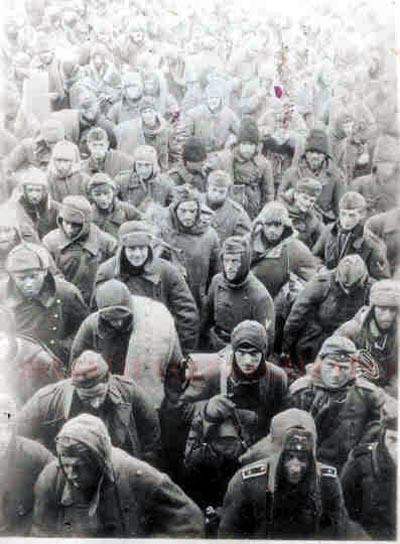 German POWs only 5000 of some 90,000 would see home again
German POWs only 5000 of some 90,000 would see home again
Operation Saturn began on 7 December destroying the Italian 8th Army and forcing the Germans to parry the threat.[cxv] A relief attempt by 57th Panzer Corps under Hoth on 12 December made some headway until a massive Soviet counterattack on 24 December drove it back.[cxvi] This attack was hampered by OKW’s refusal to allocate the 17th Panzer and 16th Motorized divisions to Manstein,[cxvii] and by 6th Army not attacking out to link with the relief force.[cxviii]By 6 January Paulus signaled OKW: Army starving and frozen, have no ammunition and cannot move tanks anymore.”[cxix] On 10 January the Soviets launched Operation Ring to eliminate the pocket and despite all odds German troops fought on. On the 16th Paulus requested that battle worthy units be allowed to break out, but the request was not replied to.[cxx] On the 22nd the last airfield had been overrun and on 31 January Paulus surrendered.[cxxi]
Analysis: What Went Wrong
Stalingrad had strangely drawn the attention of both sides, but the Russians never lost sight of their primary objectives during the campaign. The Germans on the other hand committed numerous unforced errors mostly caused by Hitler and or von Paulus. These mistakes began early in the planning and After the fall of Stalingrad as the Soviets attempted to follow up their success by attempted to cut off Army Group “A” Manstein was permitted to wage a mobile defense while Von Kleist managed to withdraw with few losses.[cxxii] The superior generalship of Manstein and Von Kleist prevented the wholesale destruction of German forces in southern Russia and Manstein’s counter offensive inflicted a severe defeat on the Soviets. However the German Army had been badly defeated. The seeds of defeat were laid early, the failure to destroy bypassed Soviet formations in July, the diversion of 4th Panzer Army from Stalingrad, and the divergent objectives of trying to capture the Caucasus and Stalingrad at the same time. This diluted both offensives ensuring that neither succeeded. Likewise the failure to recognize the culminating point when it was reached and to adjust operations accordingly was disastrous for the Germans. The failure create a mobile reserve to meet possible Russian counter offensives, and the fixation on Stalingrad took the German focus off of the critical yet weakly held flanks. The hubris of Hitler and OKW to believe that the Russians were incapable of conducting major mobile operations even as Stavka commenced offensive operations on those flanks all contributed to the defeat. Clark notes these facts but adds that the Germans “were simply attempting too much.”[cxxiii] Soviet numbers allowed them to wear down the Germans even in defeat.[cxxiv] At the same time Stalin gave his commanders a chance to revive the mobile doctrine of deep operations with mechanized and shock armies that he had discredited in the 1930s.[cxxv] All through the campaign Zhukov and other commanders maintained both their nerve even when it appeared that Stalingrad was all but lost. They never lost sight of their goal of destroying major German formations though they failed to entrap Army Group A with 6th Army.
A Modern Application
It is well and good to attempt to remain on the offensive. The U.S. currently has forces spread thinly over two combat theaters with possibilities that other threats in the same region could flare up. Like the Germans the U.S. is operating in areas, especially Afghanistan where overland supply lines are vulnerable and where weather can and does affect resupply operations by both ground and air. The fact that the U.S. is operating with just barely enough forces in areas where others have met disaster calls for a circumspect look at what our enemy’s capabilities really are and not allowing ourselves to be surprised when they do things that have worked for them in the past against the Russians. While it is unlikely that the U.S. and NATO would face a Stalingrad type situation in Afghanistan it is possible that isolated forces could be overrun as the Afghans reprise tactics used so successfully against the Soviets and as they begin to operate in larger units, concentrate them quickly and with more firepower to catch NATO forces when they are most vulnerable. It is true that they will not mass large numbers of tanks and artillery as the Soviets did against the Germans, but the principle of speed, concentration at the critical point and surprise can inflict defeats, even small ones like the attack on the US outpost in Wanat that can turn public sentiment in the U.S. and Europe against further commitments and against the war and force the NATO governments as well as the U.S. to give up the effort.
Notes
[i] Clark, Alan. Barbarossa: The Russian-German Conflict: 1941-45. Perennial Books, An imprint of Harper Collins Publishers, New York, NY 1965. p.191
[ii] Ibid.
[iii] Glantz, David M. and House, Jonathan. When Titan’s Clashed: How the Red Army Stopped Hitler. The University Press of Kansas, Lawrence KS, 1995. p.111
[iv] Ibid. Clark. p.191
[v] Beevor, Anthony. Stalingrad: The Fateful Siege: 1942-1943. Penguin Books, New York NY 1998. p.69
[vi] Manstein, Erich von. Forward by B.H. Liddle Hart, Introduction by Martin Blumenson. Lost victories: The War Memoirs of Hitler’s Most Brilliant General. Zenith Press, St Paul MN 2004. First Published 1955 as Verlorene Siege, English Translation 1958 by Methuen Company. p.291 This opinion is not isolated, Beevor Quotes Paulus “If we don’t take Maikop and Gronzy…then I must put an end to the war.” (Beevor pp. 69-70) Halder on the other hand believed that Hitler emphasized that the objective was “the River Volga at Stalingrad. (Clark. p.190)
[vii] Ibid. Beevor. p.70.
[viii] Ibid. Glantz and House. p.106
[ix] Ibid. p.105-106
[x] Ibid. Clark. p.203. The offensive did impose a delay on the German offensive.
[xi] Ibid. Clark. p.191 Each group also contained allied armies.
[xii] Ibid. p.209.
[xiii] Ibid. Glantz and House. p.119
[xiv] Ibid. Manstein. p.292.
[xv] Ibid. Clark. p.209
[xvi] Ibid. Clark. p.211
[xvii] Ibid. Glantz and House. p.120. There is a good discussion of the impact of this decision here as 6th Army’s advance was given priority for both air support and fuel.
[xviii] Ibid. Beevor. p.74
[xix] Warlimont, Walter. Inside Hitler’s Headquarters 1939-45. Translated by R.H. Berry, Presido Press, Novato CA, 1964. p.249
[xx] Ibid. Beevor. p.75 This was the 10th NKVD Division and it took control of all local militia, NKVD, and river traffic, and established armored trains and armor training schools.
[xxi] Ibid. Clark. p.212
[xxii] Ibid. Glantz and House. p.121
[xxiii] Ibid. Beevor. p.85
[xxiv] Ibid. p.89
[xxv] Liddell-Hart, B.H. The German Generals Talk. Quill Publishers, New York, NY 1979. Originally published by the author in 1948. p.202
[xxvi] Ibid. Beevor. p.88
[xxvii] Ibid. Beevor. p.90
[xxviii] Ibid. Beevor. p.81
[xxix] Ibid. Glantz and House. p.121
[xxx] Ibid. Liddell-Hart. p.202
[xxxi] Ibid. Glantz and House. p.120
[xxxii] Goerlitz, Walter. History of the German General Staff. Westview Press, Frederick A. Praeger Publisher, Boulder, CO. 1985 p.416
[xxxiii] Ibid. Beevor. pp.95-96.
[xxxiv] Von Mellenthin, F.W. Panzer Battles: A Study of the Employment of Armor in the Second World War. Translated H. Betzler, Edited by L.C.F. Turner. Oklahoma University Press 1956, Ballantine Books, New York, NY. 1971. p.193
[xxxv] Shirer, William L. The Rise and Fall of the Third Reich. A Touchstone Book published by Simon and Schuster, 1981, Copyright 1959 and 1960. p.914
[xxxvi] Ibid. Glantz and House. p.122
[xxxvii] Ibid. Warlimont. p.256
[xxxviii] Ibid. Liddell-Hart. p.203
[xxxix] Ibid. p.204
[xl] Ibid. Shirer. p.914
[xli] Ibid. Goerlitz. p.416
[xlii] Ibid. Goerlitz. p.416
[xliii] Ibid. Manstein. p.293
[xliv] Ibid. Clark. p.214
[xlv] Ibid. Beevor. pp.97-99. The mobilization included military, political, civilian and industrial elements.
[xlvi] Liddell-Hart, B.H. Strategy. A Signet Book, the New American Library, New York, NY. 1974, Originally Published by Faber and Faber Ltd., London. 1954 & 1967. p.250
[xlvii] Ibid. Beevor. p.99. Two key commanders arrived during this time frame, Colonel General Andrei Yeremenko, who would command the Stalingrad Front and General Chuikov commander of 64th Army who would conduct the defense of the city.
[xlviii] Carell, Paul Hitler Moves East: 1941-1943. Ballantine Books, New York, NY 1971, German Edition published 1963. p.581
[xlix] Ibid. Shirer. p.909.
[l] Ibid. Liddell-Hart, Strategy. p.250
[li] Wheeler-Bennett, John W. The Nemesis of Power: The German Army in Politics 1918-1945. St. Martin’s Press, New York, NY 1954. p.531
[lii] Ibid. Wheeler-Bennett. p.531
[liii] Ibid. Beevor. p.96
[liv] Ibid. Clark. p.216.
[lv] Ibid. Von Mellenthin. P.193
[lvi] See Von Mellinthin pp.193-194. Von Mellinthin quotes Colonel Dinger, the Operations Officer of 3rd Motorized Division at Stalingrad until a few days before its fall. Dingler noted that the Germans on reaching Stalingrad “had reached the end of their power. Their offensive strength was inadequate to complete the victory, nor could they replace the losses they had suffered.” (p.193) He believed that the facts were sufficient “not only to justify a withdrawal, but compel a retreat.” (p.194)
[lvii] Ibid. Manstein. p.294
[lviii] Ibid. Clark. p.216
[lix] Ibid. Clark. p.217
[lx] Ibid. Beevor. p.107
[lxi] Ibid. Beevor. p.107
[lxii] Ibid. Glantz and House. p.122
[lxiii] Ibid. Carell. P.601
[lxiv] Ibid. Beevor. p.118
[lxv] Ibid. Beevor. p.118
[lxvi] Ibid. Carell. p.602
[lxvii] Ibid. Beevor. p.128
[lxviii] Ibid. Carell. p.603
[lxix] Ibid. Beevor. p.134
[lxx] Ibid. Beevor. pp.136-137
[lxxi] Ibid. Beevor. p.149
[lxxii] Fest, Joachim. Hitler. Translated by Richard and Clara Winston, Harcourt, Brace, Jovanovich Publishers, San Diego, New York, London. 1974. p.661
[lxxiii] Ibid. Beevor. pp. 149-150
[lxxiv] Ibid. Beevor. p.164
[lxxv] Ibid. Carell. p.618
[lxxvi] Ibid. Glantz and House. p.123
[lxxvii] Ibid. Beevor. p.218
[lxxviii] Ibid. Carell. p.623
[lxxix] Ibid. Goerlitz. p.418
[lxxx] Ibid. Liddell-Hart. The German Generals Talk. p.207
[lxxxi] Ibid. Manstein. p292
[lxxxii] Ibid. Liddell-Hart. History of the Second World War. p.258
[lxxxiii] Ibid. Glantz and House. p.129
[lxxxiv] Ibid. Glantz and House. p.130
[lxxxv] Ibid. Beevor. pp.221-222 Glantz and House say that Stalin gave his backing in mid-October but this seems less likely due to the amount of planning and movement of troops involved to begin the operation in November.
[lxxxvi] Ibid. Glantz and House. p.130
[lxxxvii] Ibid. Beevor. p.226
[lxxxviii] Ibid. Glantz and House. p.132
[lxxxix] Ibid. Glantz and House. p.130
[xc] Ibid. Beevor. p.227
[xci] Ibid. Beevor. p.228
[xcii] Ibid. Clark. p.235
[xciii] Ibid. Warlimont. p.274
[xciv] Ibid, Carell. p.627 3rd Rumanian Army lost 75,000 men in three days.
[xcv] Ibid. Clark.pp.247-248
[xcvi] The condition of the few German Panzer Divisions in position to support the flanks was very poor, the 22nd had suffered from a lack of fuel and maintenance and this many of its tanks were inoperative. Most of the armor strength of the 48th Panzer Corps was provided by a Rumanian armored division equipped with obsolete Czech 38t tanks provided by the Germans.
[xcvii] Ibid. Clark. pp.251-252. The designation of 2nd Guards Tank Army by Clark has to be wrong and it is the 5th Tank Army as 2nd Guards Tank was not involved in Operation Uranus. Carell, Beevor and Glantz properly identify the unit.
[xcviii] Ibid. Carell. p.630
[xcix] Ibid. Beevor. p.244
[c] Ibid. Beevor. p.247
[ci] Ibid. Beevor. p.245
[cii] Ibid. Glantz and House. p.134
[ciii] Ibid. Glantz and House. p.134
[civ] Ibid. Clark. p.256
[cv] Speer, Albert. Inside the Third Reich. Collier Books, a Division of MacMillan Publishers, Inc. New York, NY 1970. p.248
[cvi] Heiber, Helmut and Glantz, David M. Editors. Hitler and His Generals: Military Conferences 1942-1945. Enigma Books, New York, NY 2002-2003. Originally published as Hitlers Lagebsprechungen: Die Protokollfragmente seiner militärischen Konferenzen 1942-1945. Deutsche Verlags-Anstalt GmbH, Stuttgart, 1962. p.27
[cvii] Ibid. Glantz and House. p.135 Glantz and House note that the amount of aircraft estimated to successfully carry out the re-supply operation in the operational conditions was over 1,000. The amount needed daily was over 600 tons of which the daily reached only 300 tons only one occasion.
[cviii] Ibid. Speer. p.249
[cix] Ibid. Carell. p.636
[cx] Ibid. Goerlitz. p.426
[cxi] Ibid. Clark. p.252
[cxii] Ibid. Manstein. p.303
[cxiii] Ibid. Beevor. p.276
[cxiv] Ibid. Carell. p.640
[cxv] Ibid. Glantz and House. p.140
[cxvi] Ibid. Glantz and House. p.140
[cxvii] Ibid. Clark. p.264
[cxviii] Ibid. Manstein. p.337
[cxix] Ibid. Beevor. p320
[cxx] Ibid. Beevor. p.365
[cxxi] Of the approximately 330,000 in the pocket about 91,000 surrendered, another 45,000 had been evacuated. 22 German divisions were destroyed.
[cxxii] Ibid. Liddell-Hart. The German Generals Talk. p.211
[cxxiii] Ibid. Clark. p.250
[cxxiv] Ibid. Glantz and House. p.124
[cxxv] Ibid. Beevor. p.221
Bibliography
Beevor, Anthony. Stalingrad: The Fateful Siege: 1942-1943. Penguin Books, New York NY 1998
Carell, Paul Hitler Moves East: 1941-1943. Ballantine Books, New York, NY 1971, German Edition published 1963.
Clark, Alan. Barbarossa: The Russian-German Conflict:1941-45. Perennial Books, An imprint of Harper Collins Publishers, New York, NY 1965.
Fest, Joachim. Hitler. Translated by Richard and Clara Winston, Harcourt, Brace, Jovanovich Publishers, San Diego, New York, London. 1974
Glantz, David M. and House, Jonathan. When Titan’s Clashed: How the Red Army Stopped Hitler. The University Press of Kansas, Lawrence KS, 1995.
Goerlitz, Walter. History of the German General Staff. Westview Press, Frederick A. Praeger Publisher, Boulder, CO. 1985
Heiber, Helmut and Glantz, David M. Editors. Hitler and His Generals: Military Conferences 1942-1945. Enigma Books, New York, NY 2002-2003. Originally published as Hitlers Lagebsprechungen: Die Protokollfragmente seiner militärischen Konferenzen 1942-1945. Deutsche Verlags-Anstalt GmbH, Stuttgart, 1962.
Liddell-Hart, B.H. The German Generals Talk. Quill Publishers, New York, NY 1979. Originally Published by the author in 1948.
Liddell-Hart, B.H. Strategy. A Signet Book, the New American Library, New York, NY. 1974, Originally Published by Faber and Faber Ltd., London. 1954 & 1967
Manstein, Erich von. Forward by B.H. Liddle Hart, Introduction by Martin Blumenson. Lost victories: The War Memoirs of Hitler’s Most Brilliant General. Zenith Press, St Paul MN 2004. First Published 1955 as Verlorene Siege, English Translation 1958 by Methuen Company
Shirer, William L. The Rise and Fall of the Third Reich. A Touchstone Book published by Simon and Schuster, 1981, Copyright 1959 and 1960
Speer, Albert. Inside the Third Reich. Collier Books, a Division of MacMillan Publishers, Inc. New York, NY 1970.
Von Mellenthin, F.W. Panzer Battles: A Study of the Employment of Armor in the Second World War. Translated H. Betzler, Edited by L.C.F. Turner. Oklahoma University Press 1956, Ballantine Books, New York, NY. 1971.
Warlimont, Walter. Inside Hitler’s Headquarters 1939-45. Translated by R.H. Berry, Presido Press, Novato CA, 1964.
Wheeler-Bennett, John W. The Nemesis of Power: The German Army in Politics 1918-1945. St. Martin’s Press, New York, NY 1954

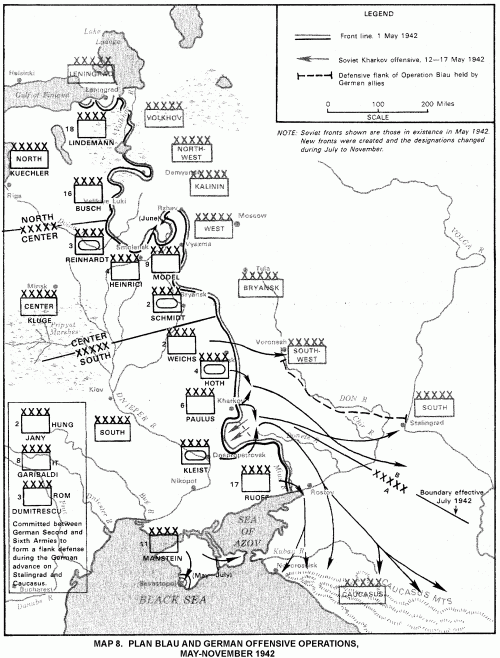



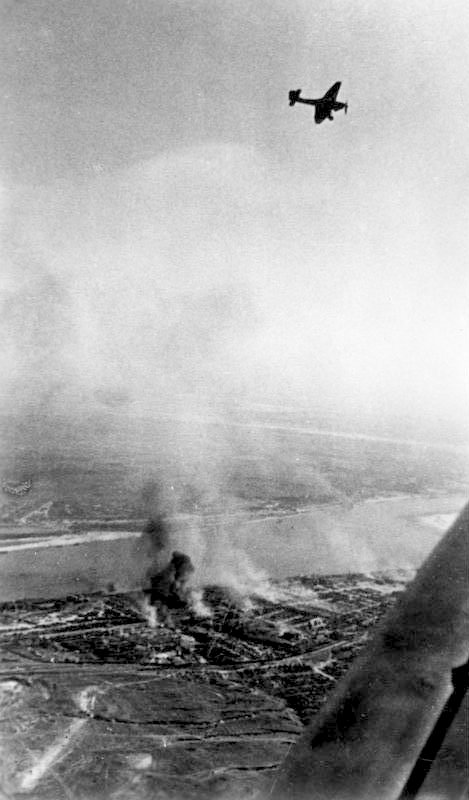


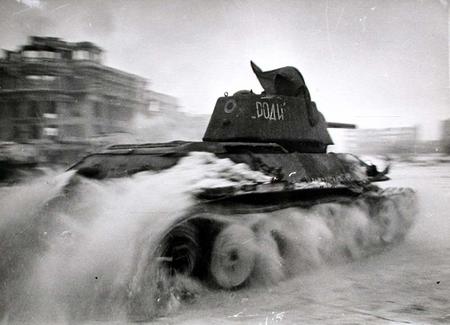


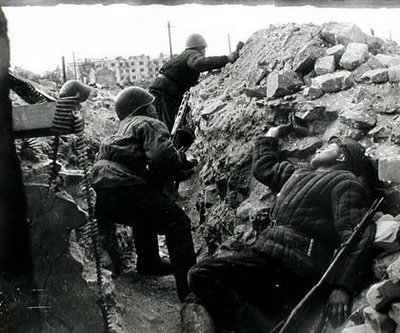
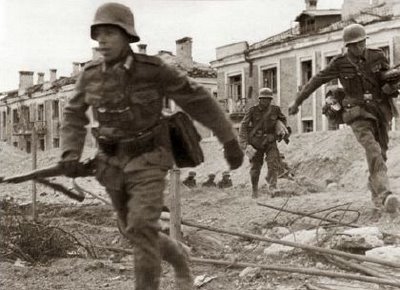

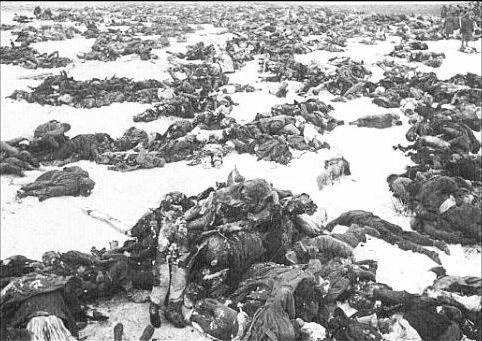

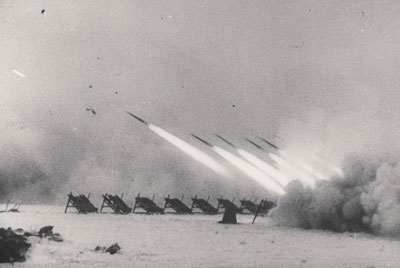
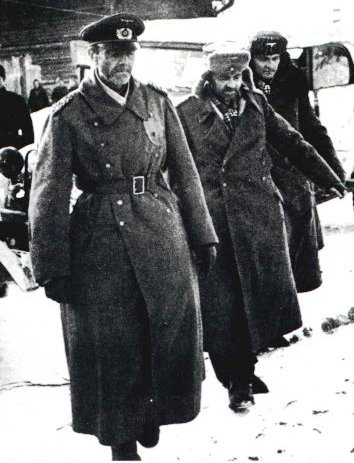

You, my friend, run an impressive blog. What an entry!
Just to add a little something to the mix, your opening image reads: (on the right side from top to bottom) “Licht, Leben, Liebe” which means “Light, Life, Love” and, on the left side, “1942, Weihnacht im Kessel” which means “1942 Christmas in the Cauldron”
“Festung Stalingrad” means “Fortress Stalingrad.”
Your essay makes me want to grab the Beevor book. A couple of years back I read his “Fall of Berlin” and got hooked on his writing.
Adam,
Thank you for your comments. I know the translation well. My German friends tell me that I’m fluent, I don’t think that I am that good, but still…
Beevor’s book is really good.
Greetings,
Thank you for your entry. My uncle perished in Stalingrad and I have been trying in vain to buy a print of Reuber’s profound charcoal drawing. Even in Germany I could not locate one – only reprints of the image in books. I would be so very grateful if you could direct me to a site? Many thanks, Ralf
I ended up downloading the picture after a Google search and printing it because I could never find one. I went to the highest resolution one I could find. It has held up well because I have a photo quality printer.
Pingback: Padre Steve’s Top 25 Articles of 2010, some Statistics and a Big Thank You to My Readers | Padresteve's World…Musings of a Passionate Moderate
Pingback: Padre Steve’s World Top 12 of 2011: A Big Thank you to my Readers | Padresteve's World…Musings of a Passionate Moderate
One photo’s caption is “German unit crossing the Volga”–where did they cross the Volga?
Mark, Thanks for pointing that out. I looked back at my photo files and the photo was German units crossing the Don. That was a typo on my part. Blessings,
Steve+
In the introduction “military’s” should be “militaries” (for the plural). Shouldn’t “weigh station” be “way station” in that translation? Maybe “…..no few than seven armies….” should be “no fewer than seven armies….” Should “disastrous compromise” be in quotation marks? Is it quoting Beevor? Maybe “Penal batallion” should be “penal battalion” “…..unable to fulfill the gaps…..” should be “unable to fill the gaps….” Should “….Quartermaster General, Wagner….” be “…..from Quartermaster General Wagner…..”? “Mountain divisions” might be right. At first I thought it shouldn’t be capitalized, or that maybe both words should be capitalized. “….imperiled the Soviet position they had…..” should maybe be “….imperiled the Soviet position where they had…..” or “….imperiled the Soviet position from which they had….” Should the hyphen in “…..of Stalingrad-a few factories…” be a dash, as in “…..of Stalingrad–a few factories”? “Without support 6th Army units….” should maybe be “Without support, 6th Army units….” I’m not sure of this. [I can’t read my note, there’s a word before the number]. The comma in “….units, 330,000 men….” should be a dash? “….units– 330,000 men…..” “This now entrapped force that would…..” Cf. “This now-entrapped force would……” or “This entrapped force would…..” “….countenance a break out…..””….countenance a breakout….” After a few sentences there is another instance of “break out” being used. Maybe the noun “breakout” is better. “…..the failure create a mobile reserve….””…..the failure to create a mobile reserve….” “…..possible Russian counter offensive….””…..possible Soviet counteroffensive….” “….Zhukov and the other commanders maintained both their nerve….””….both Zhukov and the other commanders maintained their nerve….”
Captions: “Chuikov who” should maybe be “Chuikov, who”
JU52Ju-52 JU-87Ju-87
The grammar police are active today. At least Mark’s point actually had to do with the history involved. I will have to go back and look and make changes as needed to this article.
Caption: Should “Hungarian withdraw” be “Hungarians withdraw”?
WordPress.com
padresteve commented: “Mark, Thanks for pointing that out. I looked back at my photo files and the photo was German units crossing the Don. That was a typo on my part. Blessings, Steve+”
Reblogged this on Padresteve's World…Musings of a Passionate Moderate and commented:
Friends of Padre Steve’s World , I hope that if you live anywhere in the area do the United States affected by the Polar Vortex I hope you are able to stay safe and warm. On this cold night, with the really cold air to get here later I am re-posting an older article about the Battle of Stalingrad. The is partially because I have a hardware issue on my MacBook that has killed my wifi and I am doing this on my iPad. Tomorrow I have an appointment at the Apple store and hopefully they get my machine working again. I was planning on re-posting this article anyway but the problem with the computer made it convenient to do it tonight. For those who think that the cold we are experiencing is something, try to imagine being exposed to similar elements while surrounded, with very little heat, fresh water or food and under constant attack. Personally the last time that I was out for extended periods in weather this cold was on the Iraq-Syria border in December 2007. So have a good night and stay safe and warm. Peace, Padre Steve+
I saw your article on the Stalingrad Madonna at DailyKos. It is a fine piece! My family has a connection to Kurt Reuber, since Reuber studied art under my grandfather, Heinrich Giebel (1865-1951). Giebel, like Reuber, hailed from Kassel, was trained there and in Munich, and became a central figure in the famous Willingshausen artist colony in northern Hesse. An impressionist landscape artist and portraitist, in the early 1900s, he opened an art school in Marburg/Lahn and, in 1913, was appointed university art teacher at Marburg University. Reuber studied with Giebel both in Marburg and in nearby Willingshausen, in the years around 1930.
I know from my father that Reuber’s fate deeply touched Giebel in his last years. He shared with Reuber the Bildungsbürger’s humanism and faith and, though conservative, a strong revulsion of the Nazis.
Perhaps of further interest to you, both of Giebel’s young sons –he only started his family in his 50s– were drafted into the war as well. My father fought on the Ostfront and might well have ended up in Stalingrad were it not for frost injuries in late 1941 that got him sent home and then to occupied France. After D-Day, he was among the 10% or so who escaped the Falaise Pocket. Wounded a second time in the Battle of the Bulge, he was recuperating in Marburg when the war ended.
Deeply affected by having been forced to participate in a criminal war, my father devoted his life to justice, became a judge and raised us kids to be cosmopolitan and anti-militarist. (I emigrated to the US in 1988.)
Again, thank you for that fine article on Reuber and the Stalingrad Madonna.
Christoph, I am so happy to read your comment and the story of your father. As you can tell I am an admirer of Kurt Reuber and can only imagine had I known anything about your father. From what you say I admire him greatly’
Thank you for sharing, and if you are ever in or near the Hampton Roads area of Virginia let me know.
Blessings
Steve+
Thank you for your reply and kind words about my father (who experienced all that before even turning 24).
Two more things about Reuber and his art teacher, my grandfather Heinrich:
About twenty years ago, my brother and I extensively researched our grandfather’s oeuvre (and eventually published an art book on him). He had turned 75 in 1940 and productivity naturally slowed down, but for the 1940s we tracked down a number of oil portraits of young soldiers — commissioned posthumously from photos provided by bereaved Marburg families. (Of my father’s 1938 high school graduating class, half did not return from the war.) Heinrich Giebel was 80 when he learned of his former student’s tragic end.
A few years ago, visiting Coventry and the cathedral there, I stumbled upon a side altar devoted to (a copy of) Reuber’s Stalingrad Madonna. I almost keeled over! Our family was very familiar with Reuber and the Madonna, of course, but always assumed it to be more of an inside story. Until then I had no idea how famous the Stalingrad Madonna was — worldwide.
BTW, influenced by my dad, I claimed CO status when drafted into the West German army. Trained in Vietnamese studies, I have been teaching about the wars in Viet Nam for 20 years and regularly take students to the former DMZ, Khe Sanh, etc. Funny how these things go…
Christoph,
Someday I will have to go with you to Vietnam. My dad served there in 1972, a place called An Loc. I have done a good amount of study and writing on the French experience and would love to see Dien Bien Phu, and I know many veterans of Hué City.
I am fascinated with the stories of your grandfather and Kurt Reuber.
Please stay in touch.
Peace
Steve+
Steve,
I’ll be leading an adult (not student) tour to Viet Nam, organized by PeaceTrees Vietnam, and focused on the history of the wars. Alas, we won’t be in An Loc; mostly in central VN, Hue and around the former DMZ. March 9-23, 2018. Pls. write to my university address for more details, if you were interested. I’d be happy to have you join us! I could help you extend the trip if you wanted to see An Loc and Dien Bien Phu.
Warm regards,
Christoph